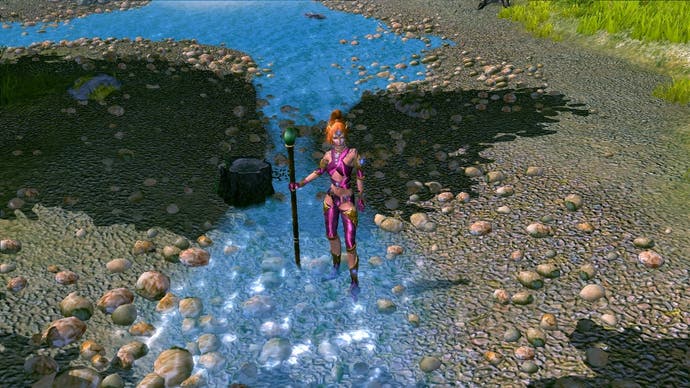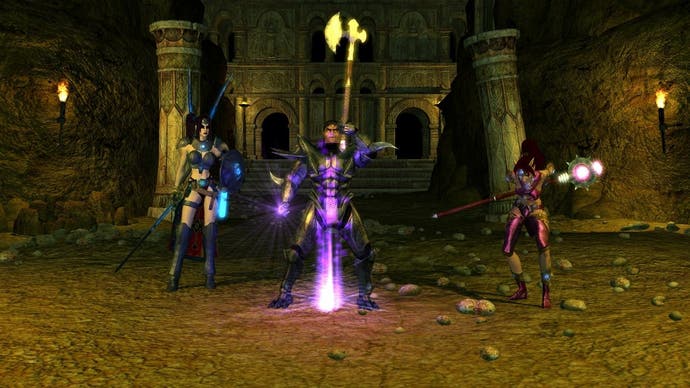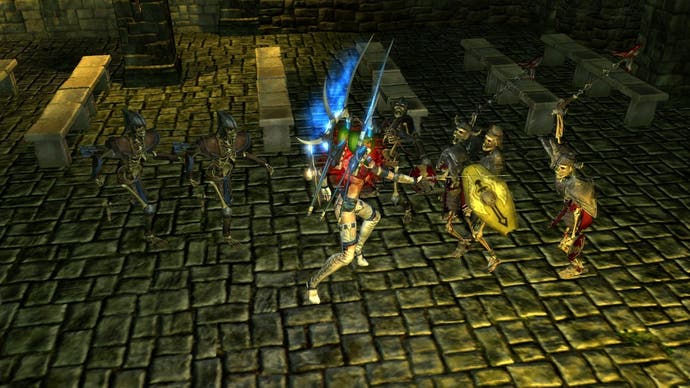Sacred 2: Fallen Angel
On your knees.
We're not sure how deliberate the choice of venue for our second look at Ascaron's forthcoming action RPG, Sacred 2, has been - but we're quietly impressed nonetheless. We're in a bar just off Oxford Street called Jerusalem; a city most notable for being, well, sacred, to three of the world's biggest religions. Nice touch.
Inside, the latest build of Sacred 2 is humming away on a bank of PCs, with the Xbox 360 build being demonstrated at one end of the room. Ascaron staff are on hand to present the game, glowing with pride at how far the game has come since its prequel was launched in 2004.
They have a point, on that front. Sacred 2 is a vast, generational leap ahead of its predecessor. Visually, it offers up a colourful, beautiful and incredibly detailed 3D world which stands proud amongst some of the nicest looking games of the last 12 months.
In gameplay terms, the range of character customisation and development options on offer helps it to stand out nicely from everything else in the genre - while the multiplayer options here may finally be the holy grail for which action RPG fans have been hunting in vain.
Two Steps Forward, Two Thousand Years Back

For such a vast leap forwards, Sacred 2 starts with an equally vast leap backwards; 2000 years, in fact, setting the series a whole two millenia before the events of Sacred. This is a sensible move - although Sacred was very popular within the action RPG genre, Ascaron is hoping to reach a whole new audience of gamers with Sacred 2. Setting the storyline so long before the original game essentially means that there's no need to know the first thing about what has come before.
The basic story is, at least, something of a departure from the usual Farm Boy Accepts His Destiny And Fights World-Threatening Evil schlock. The idea is that a divine power called T-energy has accidentally been released into the mortal world, giving its users the capacity for great technological advancement - but also causing nasty, dangerous mutations in areas where the power is tapped from underground and bubbles to the surface.
As a result of this power's emergence, the world is ruled by the High Elves, who have utilised it to build a technologically advanced society. Living alongside them (and often subservient to them) are more medieval, feudal races like the humans and the orcs, who don't use T-energy to the same extent, if at all.

There are six playable characters in the game, and interestingly, only two of them have their main storyline set out for them from the outset. There are two major quest lines that run from start to finish of the game; the Light campaign, which sees you returning the power of T-energy to the gods and removing it from the world, and the Shadow campaign, in which you harness the power to become a powerful ruler.
The Seraphim, who is the only character to return from the first game (she's the ludicrously pneumatic and badly made-up lass in the screenshots - very popular with fans, we're told, which suggests unfortunate things about how long it's been since those fans knew the touch of a woman), must follow the Light campaign - after all, it's her race that were responsible for screwing up and unleashing the T-energy in the first place, and she's been sent to clean up the mess. The Inquisitor, meanwhile, is part of an organisation devoted to using T-energy to create a new society, and must follow the Shadow campaign.
The rest of the characters, however, can pick and choose - even those whom you might expect to be "Shadow" aligned by nature, such as the Shadow Warrior. He's an undead knight, a human who served the High Elves in life and was brought back as a sword-wielding, necromancy-practising servant after his death. We approve. Various other fantasy staples populate the game, and unlike some action RPGs, there are some nicely balanced looking magic-users in the mix.

Moreover, Ascaron has focused heavily on customisation. Never mind the choice of which quest to follow with your character, the choice of how to develop your character's skills is the real meat on Sacred 2's lovely bones. As in many other RPGs (WoW springs readily to mind as an example), there are three key areas in which each character can be develop their skills, and how heavily you focus on each one is entirely up to you.
Sacred 2 goes beyond most such games by also giving you choices about how you progress individual spells and attacks. The aim is to create a game with so many combat options that it'll be rare for any two players to have the same character and play style; the developers are somewhat disparaging, in fact, about games where there are obvious, universal strategies for each class in the end-game.
The common example of how they're combatting this is the humble fireball spell - a staple of action RPGs since time immemorial (oh, alright, the mid-eighties - but can you remember much about the mid-eighties?). In most games, you can boost this spell's power as you progress; in Sacred 2, however, you can make choices about how you do so. One player may choose to advance to a fireball that shoots out three fireballs in front of you; another may opt for a single, powerful attack; a third may decide to invest in the homing capability for the attack.


.png?width=291&height=164&fit=crop&quality=80&format=jpg&auto=webp)




.jpg?width=291&height=164&fit=crop&quality=80&format=jpg&auto=webp)
